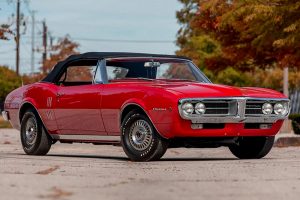Lamborghini Miura had a very special position in automotive history.
It was seen as the world’s first “supercar” – a term automotive writer LJK Setright created for this car with reference to its exotic looks, advanced design and incredible performance. The latter might be somewhat exaggerated by Lamborghini, who initially claimed it could top 300 km/h (186 mph) !
So it’s like when you have 2 million euros in the barn!

A few cars prior to the Lamborghini had tried it for road use, however, most of them were actually road-legal race cars, such as the 1954 Porsche 550 Spyder or 1964 Ford GT40. Only De Tomaso Vallelunga, which debuted one year ahead of Miura, was truly a mid-engined road car. But the 4-cylinder De Tomaso was not a supercar, of course. Lamborghini was the first one to adopt mid-engine at serious performance level.


The Bizzarrini-designed quad-cam 3929cc V12 was carried over from 400GT. Output increased from 320hp to 350hp thanks to increased compression ratio and the upright positioning of carburetors. This overwhelmed Ferrari 275GTB by as much as 50 horsepower! Road tests found the Lamborghini had a real top speed at about 170 mph, easily became the fastest car in the world.

In 1971, the ultimate Miura was born in the form of P400 SV – Italian for “Tuned Fast”. It was benefited from the development works done in Miura Jota race car. It addressed the aerodynamic lift by raising the rear suspensions while lowering the front slightly. The rear track was widened (hence a pronounced rear fenders), so were the rear tires. The chassis was stiffened again.

The engine was boosted by another 15hp thanks to another round of enlarging ports, faster cams and wild claims. The transmission was separated from engine sump to improve lubrication under high g-force. SV was unquestionably the best handling Miura of the trio, although its increased weight meant it was probably slower than the previous cars.

The most significant influence Miura made to history was that it kickstarted a 2-horse supercar race between Lamborghini and Ferrari. In 1969 Ferrari responded with Daytona 365GTB/4, which regained the world’s fastest car title from Miura. Lamborghini struck back with its even more ambitious Countach in 1974, then Ferrari counter attacked with 365/512BB… The battle still goes on today.


The orange Lamborghini Miura that appeared in the opening sequence of The Italian Job has been found.
Effectively lost since the film’s release 50 years ago (insofar as of all the orange Miuras in the world, nobody knew which one had actually appeared in the movie), chassis #3586 has finally been officially certified by Lambo’s Polo Storico department as the same car actor Rossano Brazzi drove up the Great St Bernard Pass for the film’s opening sequence.
The car in the film appeared to meet a somewhat sticky end, when it was involved in a fiery crash in a tunnel then hurled off a cliff. For a time people thought the producers had destroyed a perfectly good Miura, but it was soon established they’d used two – a pre-crashed Miura the factory had laying around, and an identical, pristine example plucked straight from the production line.
General characteristics
Dimensions
Wheelbase: 2504 mm / 98.41 in
Overall length: 4390 mm / 172.53 in
Overall width: 1780 mm / 69.95 in
Overall height: 1050 mm / 41.27 in
Front track: 1412 mm / 55.49 in
Rear track: 1541 mm / 60.56 in
Ground clear.: 127 mm / 4.99 in
Front overhang: 945 mm / 37.14 in
Rear overhang: 945 mm / 37.14 in
Weight: 1245 kg / 2745 lbs
Distribution: 44/46% front / rear
Chassis
Structure: Sheet-steel unitized body, lightened welded box sections by Bertone
Body: Monocoque steel construction with aluminium front and rear sections
Suspension: All-independent, consisting of double transverse wishbones with coil springs, telescopic shock absorbers and anti-roll bars
Brakes: All-wheel Girling ventilated disc brakes, operated by two vaccuum servo units with independent circuits to front and rear
Front: 267 mm / 10.49 in
Rear: 267 mm / 10.49 in
Steering type: Unassisted rack and pinion
Front: tyre size FR60 VR-15
Rear: tyre size FR60 VR-15
Type: Pirelli Cinturato Belted
Front: rim size 7×15 inch
Rear: rim size 9×15 inch
Type: Campagnolo cast magnesium with knock-off’s
Engine
Type: V-12 60 degree, light-alloy block with gearbox and differential built in the same block and pressed-in liners mid mounted, rear wheel drive
Distribution: Dual overhead camshafts, chain drive, two valves/cyl.
Main Bearings: 7
Cyl.Capacity: 3939 cc / 240 ci
Bore & stroke: 82 x 62 mm
Compr. Ratio: 10.7:1
Max.power: 385 Bhp at 7850 rpm
Max.torque: 400 Nm at 5750 rpm
Cooling system: Cross-flow radiators and twin electric fans
Ignition: Two coils and two Marelli distributors
Plugs Bosch: 235 P21
Electr.system: 12 V
Alternator: 770 W
Fuel system: Single electric Bendix fuel pump, 4 tripple-choke Weber 40 IDL 3C carburetors
Fuel type: 100 Octane
Fuel cons.: n.a.
Lubrication: Wet sump, common engine-transmission lubricant, dry sump on SVJ
Drivetrain
Type: Lamborghini five-speed + reverse manual all-synchromesh
Clutch: Dry-single plate, hydraulically operated
Disc diameter: 266.7 mm / 10.48 in
1st gear ratio: 2.520:1
2nd gear ratio: 1.735:1
3rd gear ratio: 1.225:1
4th gear ratio: 1.100:1
5th gear ratio: 0.815:1
Rev. gear ratio: 2.765:1
Final drive ratio: 4.090:1
Performance
Top speed: 300 Km/h / 186 Mph
0 – 100 Km/h: 6.50 sec.
Standing Km: 24.00 sec.
Capacities
Fuel: 90 Liter / 24 Gallon
Engine oil: 14 Liter / 4 Gallon
Cooling system: 14 Liter / 4 Gallon
Luggage: 140 Liter / 37 Gallon
Share this:
- Click to share on Facebook (Opens in new window)
- Click to share on Twitter (Opens in new window)
- Click to print (Opens in new window)
- Click to share on LinkedIn (Opens in new window)
- Click to share on Reddit (Opens in new window)
- Click to share on Tumblr (Opens in new window)
- Click to share on Pinterest (Opens in new window)
- Click to share on Pocket (Opens in new window)
- Click to share on Telegram (Opens in new window)
- Click to share on WhatsApp (Opens in new window)





Pingback: 1968 Lamborghini Espada 400 | Welcome to the 007 World!